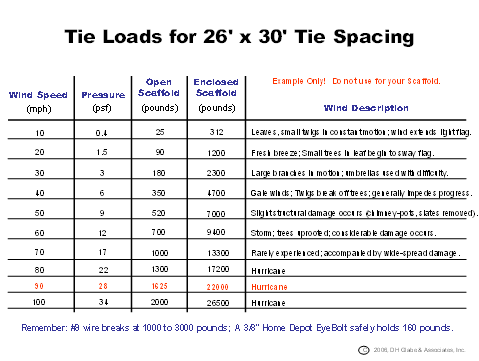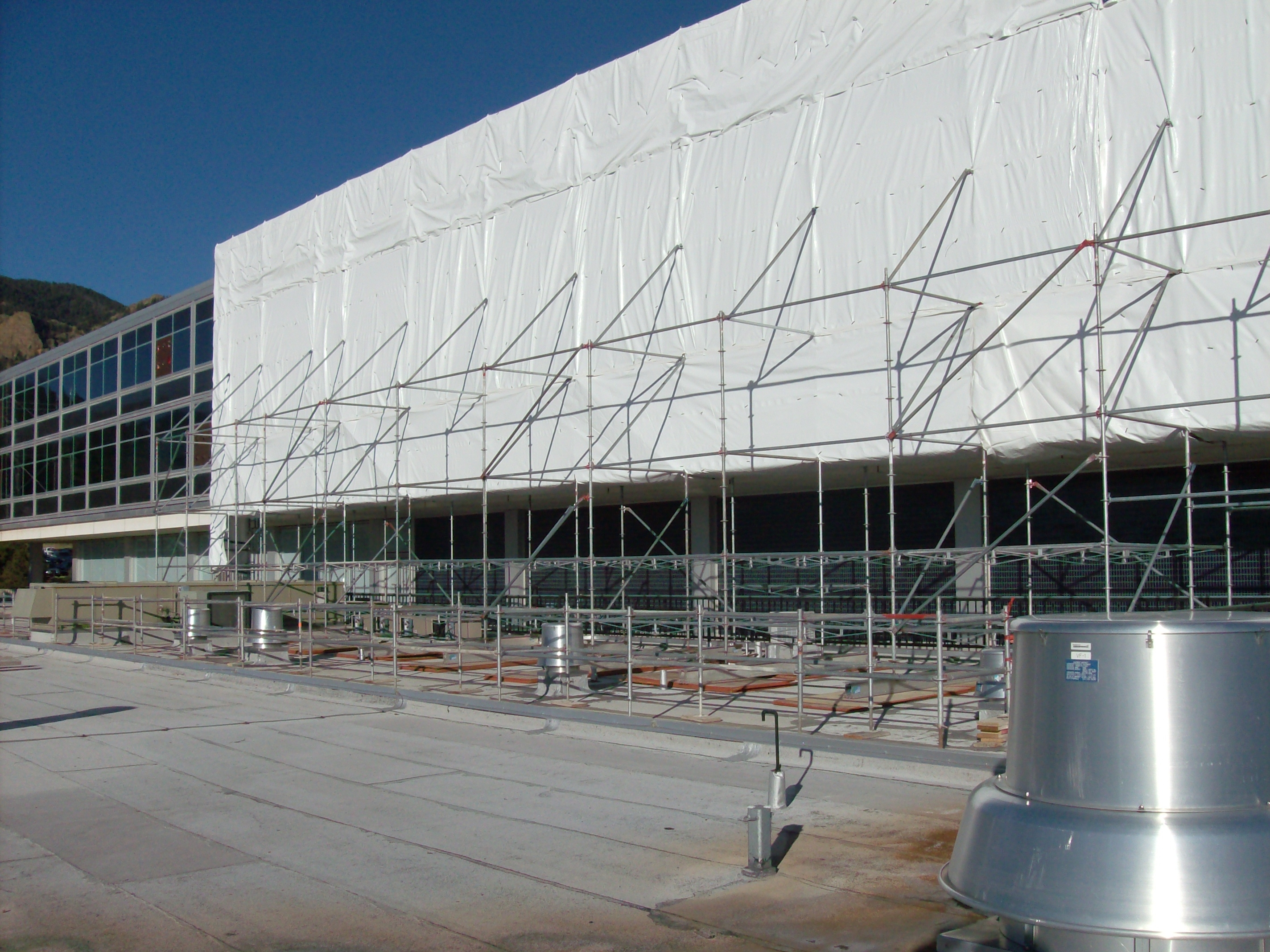It is not a healthy or a safe thing when scaffolds fall over. Consequently, and not surprisingly, there are codes and standards that address scaffold stability and the minimum expectations regarding scaffold stability. Both OSHA and ANSI, the American National Standards Institute, have minimum standards for the stability of scaffolds. Simply stated, scaffolds must be secured to an existing substantial structure to make sure they don’t fall over. While both agencies specify that the connections, or ties, be spaced no further apart than 26 feet vertically and 30 feet horizontally, (20 feet by 30 for scaffolds 3 feet and narrower), the codes are silent regarding the strength or the expected load on the tie. In some ways the codes are misleading in that they may imply to the untrained worker that the prescribed spacing is both the minimum and maximumspacing of the ties. In other words, no matter whether the scaffold is wrapped in an enclosure or not, the spacing remains the same. Such is not the case!
Scaffolds must be designed by a qualified person, basically an individual who knows what he/she is doing. If the scaffold is going to be enclosed, the qualified person must be familiar with wind forces, velocity, and environmental effects, in addition to other factors. Where the scaffold is located, the shape of the scaffold, the shape of the structure, whether you are in Chattanooga or Casper, the height of the scaffold, if the windows are open or not, if the scaffold is in the city center or suburbs, and the height of the structure and the scaffold, are all factors that must be considered. This is not time for guesswork and yet that is exactly what occurs.
One classic approach is to “double up the ties.” Fortunately this works for a lot of scaffolds, not because it is accurate but because the scaffold erector is lucky. That’s right, lucky. Believe it or not, the force on the scaffold can be accurately calculated. Much research has been conducted by engineers to determine the force of the wind on structures. Several years ago a horrific accident occurred inChicagowhere a suspended scaffold failed and fell to the street, killing innocent people. The ensuing investigation determined the vertical force on the scaffold due to the wind was over 11,000 pounds! This is serious stuff and yes, the forces can be calculated.
Lucky for the scaffold industry, compliance and safety workers generally cannot determine the forces on a wrapped scaffold and consequently cannot determine if an enclosed scaffold is at risk or not. But this is changing.
Figure 1 illustrates a scaffold at the Air Force Academy that was wrapped. That area ofColoradocan experience high winds, in excess of 100 mph. That’s like a Category 2 hurricane. Is it possible to design a scaffold that can resist this kind of wind? Sure—look at Figure 1. Was this scaffold designed on the fly by doubling up the ties and hoping for the best? No, it was designed by a qualified person, who appropriately applied engineering principles that resulted in a safe design and successful installation. The bottom line: Comply with the applicable standards and good construction practice: Have a qualified person design the scaffold and construct the scaffold according to that design. (How about that, there are ANSI and OSHA standards that say exactly that.) So, how much force does the wind exert?

Figure 2 shows an example of the types of forces that can be expected. Note how the pressure increases dramatically as the wind speed increases. In other words, at low wind speeds there isn’t much load on the scaffold but as the wind velocity increases, the pressure or force increases much faster. Notice what happens at 90 mph. Based on a tie spacing of 26 feet by 30 feet, the load on that tie is 1,625 pounds for an open scaffold but when it is enclosed, that load goes to 22,000 pounds. That cheap eyebolt you’re using to hold that wire tie just isn’t going to fare well. You may say that you don’t get 90 mph winds. While that may be true, you can easily get 50 mph wind gusts and of course, you only need one gust to ruin your day.
What about the second issue, the issue where OSHA considers the enclosure installation as not being a part of the scaffold erection? This is a sensitive issue. Basically, OSHA is claiming that the enclosure is not a structural part of the scaffold and thus is not part of the scaffold erection. Therefore, fall protection, either a guardrail system or personal fall protection system, is required for the enclosure installers; the OSHA Subpart L fall protection standards, 29 CFR 1926.451(g) apply. However, OSHA chooses to ignore the fact that if a structure is erected solely for the purpose of supporting an enclosure, it is not a scaffold in spite of the fact that scaffold components are used to support the enclosure. By definition, a scaffold is a temporary elevated platform and it’s supporting structure, used to support workers or materials or both. If there is no elevated platform, there is no scaffold; the structure is a structure. OSHA Subpart M would apply in this case. What do we do? Stay tuned, we’re working on it.













